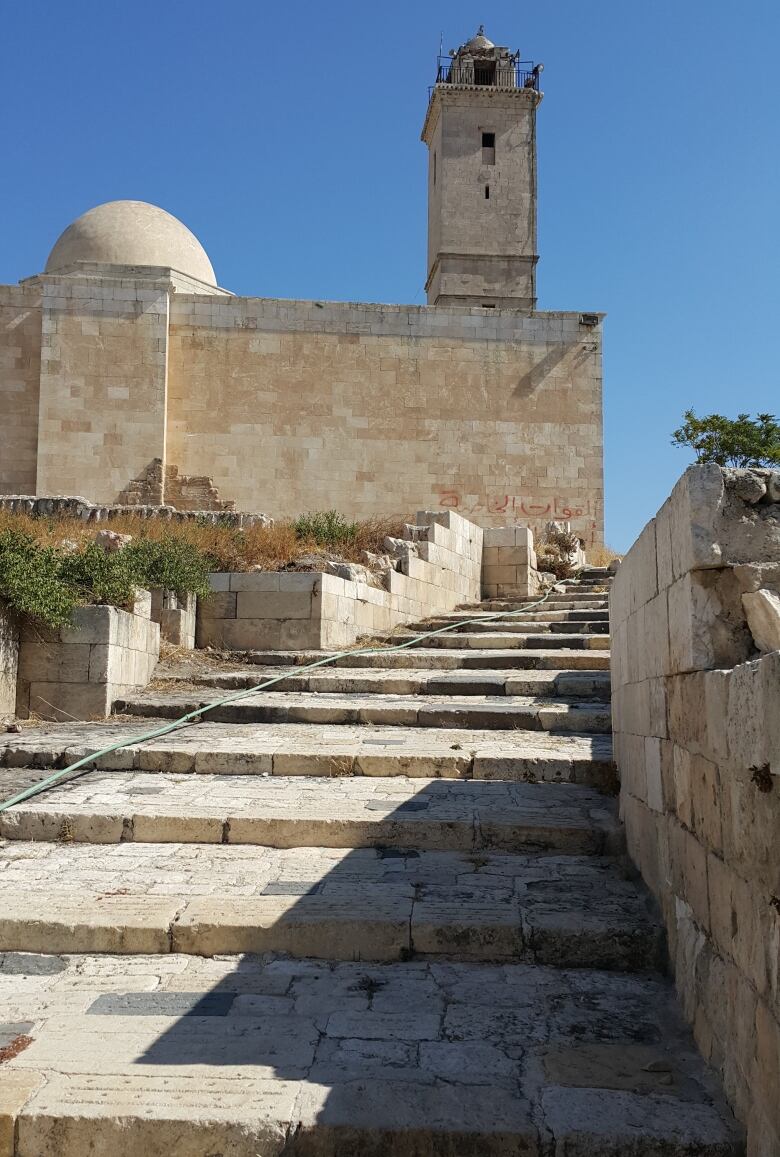'How will this war ever end?': Shells and bombs a normal part of life for 2 million in Aleppo
War has blasted away beautiful buildings, but Syria's largest city still has traffic jams

Today is like every other day in Aleppo, and George has long grown used to it. A Syrian photographer and native of Aleppo, he knows how to interpret the sounds of outgoing artillery, incoming mortars and air attacks.
Like many civilians in Aleppo during this war, George goes only by his first name. After four years of gruesome war in Syria's largest city, he responds with equal emotion to traffic jams and danger.
Yes, there really are traffic jams in the city's western markets, and George curses his way past the cars when he's on assignment.
But when he hears jets power-diving over the rebel-held east section of Aleppo, he responds calmly.
"Sometimes I can see the Syrian planes and even photograph them," he says. "But the Russian bombers are totally invisible. We can only hear their sound."

Since Russian President Vladimir Putin decided to defend the Syrian regime of Bashar al-Assad against his American- and Gulf-backed enemies, Russia's bomber pilots have been supporting the Syrian army in its struggle to regain control of the country.
George lives on the west side of this cruelly divided city in northern Syria. The people of Aleppo did not join Syria's war until 12 months after the conflict started in the rest of the country five years ago.

Today, two million civilians live under government control in west Aleppo and perhaps 400,000 in the east which is run by a combination of rebel groups. They include the al-Qaeda linked Nusra, the fighters of ISIS and other small Islamist and opposition factions, according to another Aleppo resident who works with the UN. He doesn't want to be identified for his security.
He goes to the rebel-held east of Aleppo as part of his work and insists that many people in Aleppo, like him, refuse to take sides in this bloody war. "Not all the people who live under government control support the al-Assad regime, nor do those who live on the other side support the opposition to Assad's government," he says.
"Some stayed here in Aleppo because they want to live in their city, others are trapped. To go anywhere you need money, and not everyone can afford to flee."
And so shells and bombs have become a normal part of life.
Shortages, but 'no starvation'
In west Aleppo shops are open, and roadside stalls display vegetables and fruits. "There are shortages of things, though there's no starvation," he says. "More than a month ago, there was no water for about six weeks and no power."
Despite the rumble of explosions, there is a rush of shoppers before Eid al-Fitr, the holiday that marks the end of Ramadan. Traffic jams are as common as military checkpoints and there are three-kilometre queues at gas stations, where fuel prices have just risen by 40 per cent on government instructions.

"A few months ago, things were improving for the government forces," he says. "But there was a ceasefire and the other side rearmed and now the Syrian soldiers don't have enough men to advance. The army north of the city is having a hard time."
He passes the desolate old Baron Hotel, undamaged but long closed to guests. Those guests once included Lawrence of Arabia and Agatha Christie. Lawrence famously failed to pay his champagne bill at the Baron.
"Baron Street receives the most rockets fired during the day and at night," says George.
Beautiful buildings blasted away
A few hundred metres farther east, the beautiful buildings of ancient Aleppo have been blasted away. The souk of Abdul Hamid — the world's first shopping mall, according to the people of Aleppo — is a place of ash and rubble, the minaret of the great Ommayad Mosque lying in a pile of stones, the walls of smaller mosques broken open by shells.
In one half-destroyed mosque, dust-covered chandeliers still hang from the ceiling.
But on the other side of the front line along which George walks, people live among ruins. Their smashed homes sit behind the embankments of sand, wrecked trucks, garbage and huge metal sheets placed across the streets to stop snipers and suicide car bombs.

To reach their lonely outpost, you must climb down a set of stairs in a ruined apartment block and then stumble along a narrow, dusty tunnel built centuries ago by medieval Muslim warriors.
"Turn cameras and recording equipment off. Don't take pictures, don't speak because they can hear you above us," says a soldier. With two fingers pressed over his lips, he orders silence. No name, no rank — and he is not in a mood to talk.
Holding his radio over his chest, using a dim light from his mobile phone, the soldier steps through the tunnel, over uneven ground and puddles covered by plastic boxes.
At the other end stands an iron-clad rusted door leading to a cool, shaded archway, and then to the blinding sun-flooded plateau.
The ruins are intact but there are no warriors' swords or armour here, only spent cartridge cases along the millennium-old steps, and bullets near the entrance to the grand hall.
The echoing Hall of Thrones with its inlaid marble floor, painted wooden ceiling and thick stone walls is a fortress for the Syrian army's gun positions overlooking the broken city beneath.


